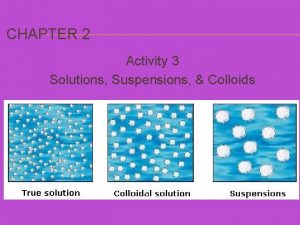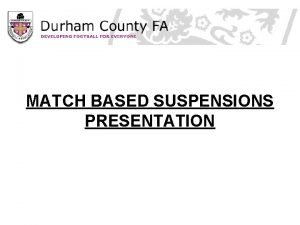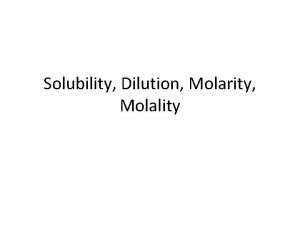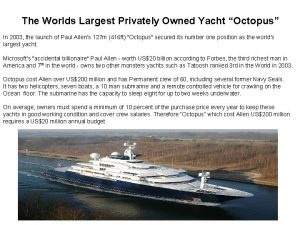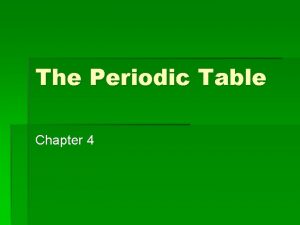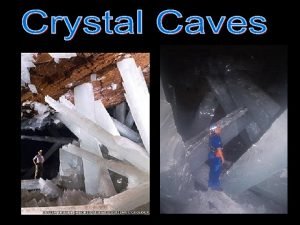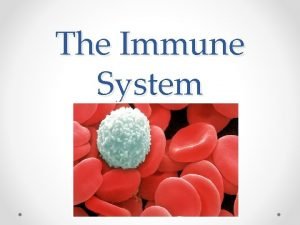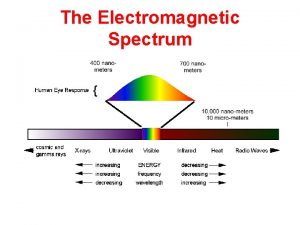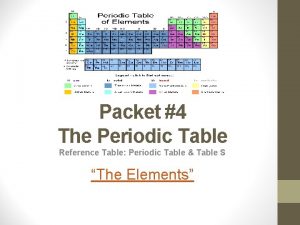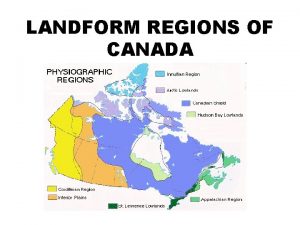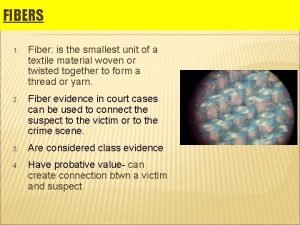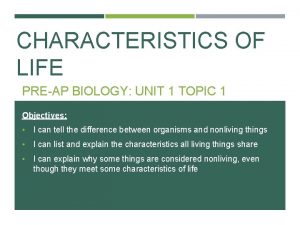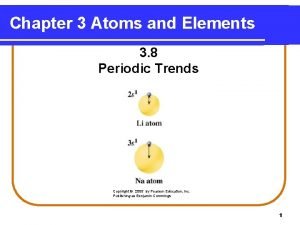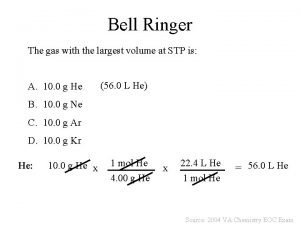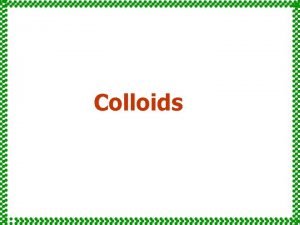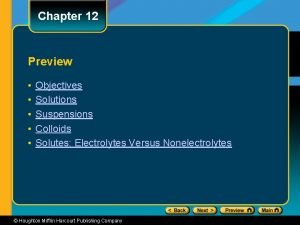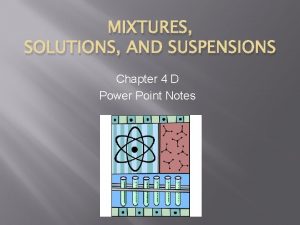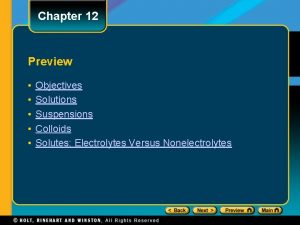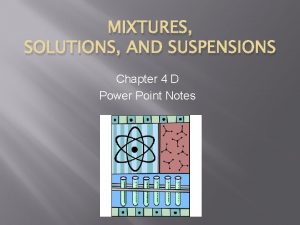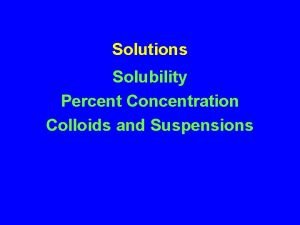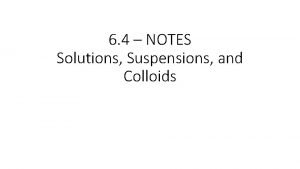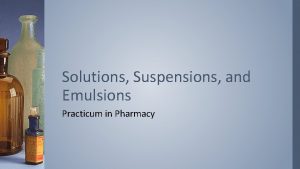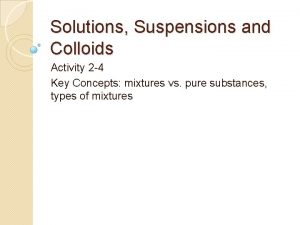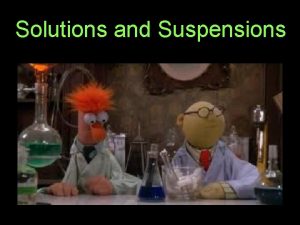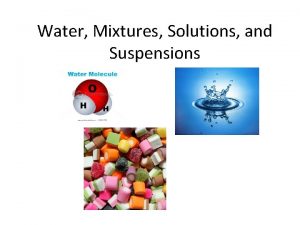Solutions Chapter 12 Types of solutions Suspensions largest


























































- Slides: 58

Solutions Chapter 12

Types of solutions • Suspensions – largest particle size – > 1000 nm – Blood, paint, aerosols, muddy water • Colloids – mid sized particles – 2 -1000 nm – Milk, fog, butter • Solution – smallest particles – <2 nm – Air, seawater, gasoline

Types of colloids Aerosol – liquid in gas Solid Aerosol – solid in gas Sol -- solid in liquid like protein particles in milk

Emulsion – liquid in liquid like oil droplets in mayonnaise. Foams – gases in liquids like whipped cream Solid emulsion – liquid in a solid like milk in butter Gel – a solid emulsion which is soft but holds its shape like Jell-O

Key terms • Solution - A general term for a solute dissolved in a solvent. A homogeneous mixture of 2 or more components in which particles intermingle at the molecular level. • Solvent - The component of a solution that is the greater quantity. • Solute - The component of a solution that is the lesser quantity.

• • Solution Types Gas in gas Gas in liquid Gas in solid Liquid in liquid Miscible - refers to 2 or more liquids that are infinitely soluble in one another. Immiscible - refers to 2 liquids that are not soluble in one another and if mixed separate into 2 layers. • Liquid in solid • Solid in liquid • Solid in solid

Dissolving process solute particles are surrounded by solvent particles and begin go move through the solution in a “solvent cage”. – Ions surrounded by water molecules are called hydrated ions.


Energetics of Dissolving Process • G = H - T S • H can be either + or -, it depends on – the enthalpy to break the crystal apart – the enthalpy of disrupting solvent structure – the enthalpy change for hydrating solute. • S is generally positive.

Energetics of Dissolving Process Costs energy to disrupt solvent and solute structure. H = + Formation of solvent-solute interactions releases energy. H = −




• 1. 36 g of Mg. Cl 2 are dissolved in 47. 46 g of water to give a solution with a final volume of 50. 00 m. L. Calculate the concentration of the solution in mass %, ppm, mole fraction, molarity, and molality.






• Hydrochloric acid is sold as a concentrated aqueous solution. The concentration of commercial HCl is 11. 7 M and its density is 1. 18 g/m. L. Calculate the mass percent of HCl in the solution. Calculate the molality of the solution.

• Concentrated sulfuric acid has a density of 1. 84 g/m. L and is 18 M. What is the mass % H 2 SO 4 in the solution? What is the molality of H 2 SO 4 in the solution?


Solubility - the maximum amount of solute than can dissolve in 100 g of solvent at a given temperature. • Saturated solution - a solution that contains the maximum amount of dissolved solute that will dissolve at a given temperature. Unsaturated solution - a solution that contains less solute than can be dissolved at a given temperature. • Supersaturated solution - a solution that contains more dissolved solute than will ordinarily dissolve at a given temperature.

Factors Affecting Solubility

Temperature • For gases, solubility decreases as temperature increases. • For liquids and solids solubility generally increases as temperature increases.



Pressure • Pressure has very little effect on the solubility of liquids and solids. • Pressure is very important to the solubility of gases however.


Henry’s Law • The solubility of a gas is directly proportional to its partial pressure above the solution. • Or Solubility = k. P – where k = henry’s law constant

• The solubility of pure N 2 (g) at 25 o. C and 1. 00 atm pressure is 6. 8 x 10 -4 mol/L. What is the solubility of N 2 under atmospheric conditions if the partial pressure of N 2 is 0. 78 atm?

• The solubility of pure N 2 (g) at 25 o. C and 1. 00 atm pressure is 6. 8 x 10 -4 mol/L. What is the solubility of N 2 under atmospheric conditions if the partial pressure of N 2 is 0. 78 atm?

Colligative Properties


Vapor pressure lowering • The vapor pressure of a solution is always lower than the vapor pressure of the corresponding pure solvent. • Raoult’s Law • P solution = (P solvent )(X solvent)

• What is the vapor pressure of a solution made of 10. 0 g of glucose and 100. 0 g water at 37. 0 o. C? (Vapor pressure of water at 37 o. C is 47. 1 torr. )


Why is vapor pressure lowered in solutions? • Gvap = Hvap - T Svap


Solutions with a volatile solute • P total = PA + PB • PA = (XA)(PAo) • PB = (XB)(PBo) – PAo is the vapor pressure of the pure solvent.


Boiling point elevation • A non-volatile solute raises the boiling point of a solvent. • Tb = Kb m where – Tb = boiling point elevation – Kb = a constant – m = molality

Freezing point depression • A non-volatile solute depresses the freezing point of a solvent. • Tf = Kf m where – Tf = freezing point depression – Kf = a constant – m = molality


• Calculate the FP and BP of a solution containing 100 g of ethylene glycol (C 2 H 6 O 2) in 900 g H 2 O. • For water • Kb = 0. 52 o. C/m Kf = 1. 86 o. C/m

• Tartaric acid can be produced from crystalline residues found in wine vats. It is used in baking powders and as an additive in foods. Analysis show that it is 32. 3%C, 3. 97% H, and the remainder O. When 1. 161 g tartaric acid is dissolved in 11. 23 g water, the solution freezes at – 1. 26 o. C. Determine the empirical and molecular formula for tartaric acid.

Osmotic Pressure




Osmotic Pressure • π = MRT where – π = osmotic pressure – M = molarity – R = ideal gas constant – T = temperature in K

• For a solution containing 3. 00 g of pepsin in 10. 0 m. L of solution π = 0. 213 atm at 25 o. C. What is the molecular mass of pepsin?



Colligative properties of electrolytes • Colligative properties depend on the number of particles in solution. • Van’t Hoff factor


New equations • Tb = i. Kb m • Tf = i. Kf m • π = i. MRT

• The freezing point depression constants for the solvents cyclohexane and naphthalene are 20. 1 o. C/m and 6. 94 o. C/m respectively. Which would give a more accurate determination by freezing point depression of the molar mass of a substance that is soluble in either solvent? Why?
 Is cereal and milk a solution colloid or suspension
Is cereal and milk a solution colloid or suspension Suspension solution
Suspension solution Durham fa suspensions
Durham fa suspensions Ingredients for suspensions
Ingredients for suspensions Advantages of flocculated suspensions
Advantages of flocculated suspensions Molarity by dilution worksheet answers
Molarity by dilution worksheet answers Worlds biggest engine
Worlds biggest engine Largest steamboat in the world
Largest steamboat in the world What is the largest vegetation region in canada
What is the largest vegetation region in canada Largest islamic empire
Largest islamic empire Three gorges dam spillway
Three gorges dam spillway Lewisham council electoral roll
Lewisham council electoral roll Octopus yacht position
Octopus yacht position Largest employer in singapore
Largest employer in singapore Continent
Continent Which is the largest continent
Which is the largest continent Smallest atomic radius
Smallest atomic radius Largest crystals
Largest crystals Chapandaz kite runner
Chapandaz kite runner Largest lymphoid organ
Largest lymphoid organ Electromagnetic spectrum longest to shortest wavelength
Electromagnetic spectrum longest to shortest wavelength Largest cal state campus
Largest cal state campus Largest part of the brain
Largest part of the brain Planet.click
Planet.click Largest sports organization in the world
Largest sports organization in the world Thick skin
Thick skin Largest naturally occurring element
Largest naturally occurring element The largest branch of the brachial plexus
The largest branch of the brachial plexus Largest atomic radius
Largest atomic radius Periodic reference table
Periodic reference table What is the mission of the ffa
What is the mission of the ffa Elements of a system of care
Elements of a system of care Xavier daniel lopez,
Xavier daniel lopez, London is one of the largest cities in the world positive
London is one of the largest cities in the world positive K strategist curve
K strategist curve Landform regions map of canada
Landform regions map of canada What year was muhammad born
What year was muhammad born Schools of islam
Schools of islam Levels of biological organization from smallest to largest
Levels of biological organization from smallest to largest The internet is the world's biggest
The internet is the world's biggest Largest empire in india
Largest empire in india Largest papillae on tongue
Largest papillae on tongue Lymphatic system organs and functions
Lymphatic system organs and functions The smallest unit of fabric is called
The smallest unit of fabric is called Hinduism subgroups
Hinduism subgroups Largest economy in latin america
Largest economy in latin america Producers
Producers Largest ossicle
Largest ossicle Largest naturally occurring element
Largest naturally occurring element Biological organization from smallest to largest
Biological organization from smallest to largest What is the world's largest industry
What is the world's largest industry Largest atomic radius
Largest atomic radius Largest lymphatic duct
Largest lymphatic duct Subculture and consumer behaviour
Subculture and consumer behaviour Correct order from smallest to largest
Correct order from smallest to largest Is canada the second largest country
Is canada the second largest country Xxx bellringer
Xxx bellringer The capital and largest city of greece
The capital and largest city of greece Is africa the second largest continent
Is africa the second largest continent
